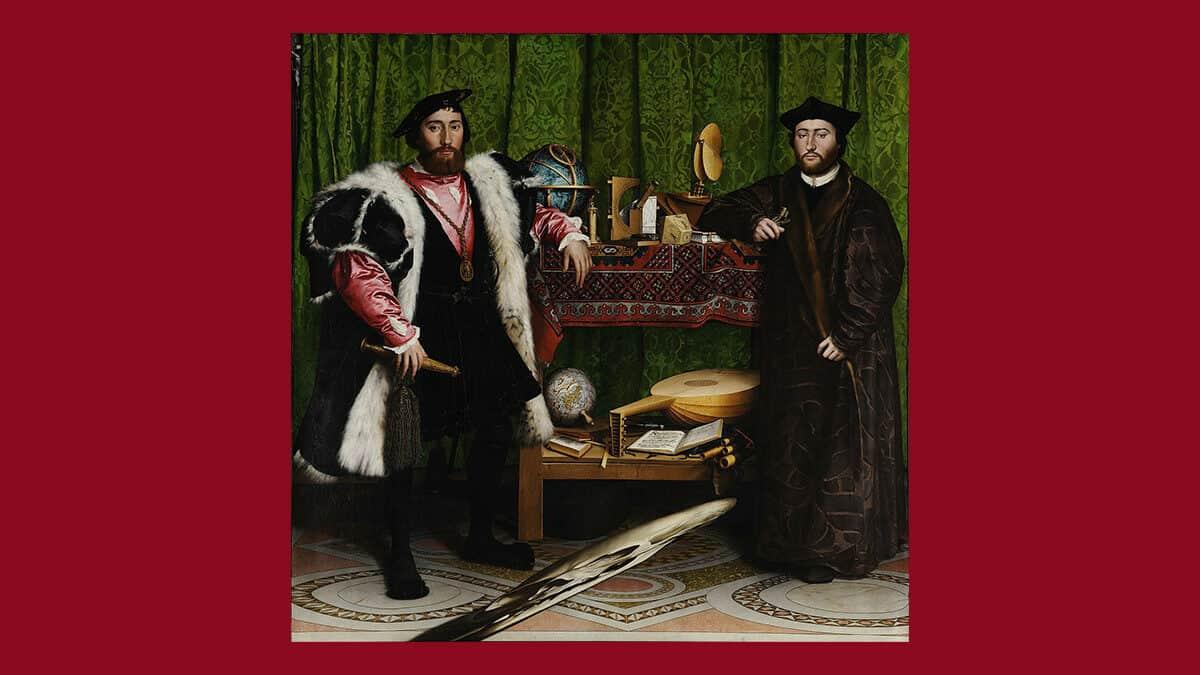Sometimes, if you look carefully at paintings, you’ll see lots of secret messages. The Ambassadors has lots of hidden meanings and secrets. Take a look! There are two men in the painting. They’re wealthy, educated and powerful. On the left if Jean de Dinteville, the French ambassador to England at 29, and the right there’s Georges de Selve, aged 25, bishop of Lavaur, who had acted as ambassador to the Emperor of the Venetian Republic and the Holy See.
If you look around them, there are loads of books and instruments. On the highest shelf, there’s s a globe of the sky, a portable sundial and other things to help measure the heavens and time. On the lower shelf, there is a lute, a case of flutes, a hymn book, a book of arithmatic, and a globe of Earth.
There are things here you can say are religious – the broken lute string might symbolise discord and the hymn book could be a plea for Christian harmony.
The biggest message is seen in the foreground. Can you see that stretched grey and black streak? That is actually a skull if you step to the side of the painting. You see, the perspective is distorted. Ever watch a football match and the logos on the pitch look all distorted, but look 3d when you look at them face-on? It’s the same thing!
Here are Jean and George’s stories:
My name is Jean, Ambassador from France I am – that’s me!
… and I am George – a humble cleric – hearty friends are we!
Now in this painting you will find the wonders of our age,
Laid out in all their finery – they take the centre stage!
Globes and telescopes you’ll see in every shape and size!
Fine instruments to make us very masters of the skies
And below you see the ways we mould the earth that lies below
Earthy blessings, music books – so proud they are on show
Look carefully dear child at all the treasures we display
Be certain that such Earthly things will someday… fade away.
The heavens up above which we can capture with our glass,
And scribe inside our leather covered tomes – they cannot last!
We may measure all the oceans with our fine machinery,
And span the land and craft the globe to capture earth and sea
But…
See what lies before us ‘mongst the trinkets and the gold?
A skull lies at our feet – a message Holbein wanted told.
The skull lies in the foreground but I’ll wager you can’t see,
Until you take the time to think of your MORTALITY.
Riches fade like painted lords, gold crumbles like the frame
That we must die –
that is the only truth that will remain.
Can you make your own secret message in a painting?
Making the perspective change like Holbein’s painting is a bit tricky, but see if you can hide a message another way!
Could you spell out a word in some tree branches? Or think of your own symbols for things? See if you can decipher some more hidden messages in this painting for some clues!
Why did Holbein use a skull?
Have you seen the play Hamlet? There’s a skull in it too. Skulls don’t just symbolise death, they symbolise mortality. Skulls are used as symbols Mexico for the Day of the Dead celebrations – it’s the same thing, except they celebrate mortality and that one day we will die. So next time you see a skull in a painting, play, or a festival, you know why!
What other symbols are important in the painting?
Religion was a very big factor in those times. There were no newspapers, TV or radio back then. All the information you knew about the world came from the church you went to on Sunday, or word of mouth. Even things like medicine were all distributed by the church! And, if you didn’t go to church, you’d be arrested, so you can see why there are lots of religious symbols in here.





